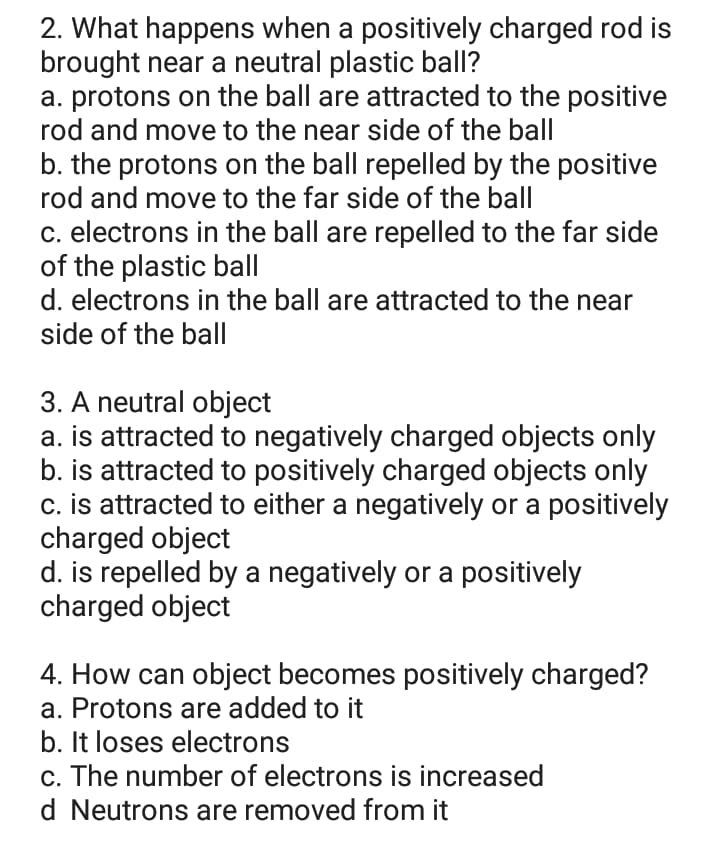2. What happens when a positively charged rod is brought near a neutral plastic ball? a. protons on the ball are attracted to the positive rod and move to the near side of the ball b. the protons on the ball repelled by the positive rod and move to the far side of the ball c. electrons in the ball are repelled to the far side of the plastic ball d. electrons in the ball are attracted to the near side of the ball 3. A neutral object a. is attracted to negatively charged objects only b. is attracted to positively charged objects only c. is attracted to either a negatively or a positively charged object d. is repelled by a negatively or a positively charged object 4. How can object becomes positively charged? a. Protons are added to it b. It loses electrons c. The number of electrons is increased d Neutrons are removed from it
2. What happens when a positively charged rod is brought near a neutral plastic ball? a. protons on the ball are attracted to the positive rod and move to the near side of the ball b. the protons on the ball repelled by the positive rod and move to the far side of the ball c. electrons in the ball are repelled to the far side of the plastic ball d. electrons in the ball are attracted to the near side of the ball 3. A neutral object a. is attracted to negatively charged objects only b. is attracted to positively charged objects only c. is attracted to either a negatively or a positively charged object d. is repelled by a negatively or a positively charged object 4. How can object becomes positively charged? a. Protons are added to it b. It loses electrons c. The number of electrons is increased d Neutrons are removed from it
College Physics
1st Edition
ISBN:9781938168000
Author:Paul Peter Urone, Roger Hinrichs
Publisher:Paul Peter Urone, Roger Hinrichs
Chapter18: Electric Charge And Electric Field
Section: Chapter Questions
Problem 53PE: A simple and common technique for accelerating electrons is shown in Figure 18.55, where there is a...
Related questions
Question

Transcribed Image Text:2. What happens when a positively charged rod is
brought near a neutral plastic ball?
a. protons on the ball are attracted to the positive
rod and move to the near side of the ball
b. the protons on the ball repelled by the positive
rod and move to the far side of the ball
c. electrons in the ball are repelled to the far side
of the plastic ball
d. electrons in the ball are attracted to the near
side of the ball
3. A neutral object
a. is attracted to negatively charged objects only
b. is attracted to positively charged objects only
c. is attracted to either a negatively or a positively
charged object
d. is repelled by a negatively or a positively
charged object
4. How can object becomes positively charged?
a. Protons are added to it
b. It loses electrons
c. The number of electrons is increased
d Neutrons are removed from it
Expert Solution
This question has been solved!
Explore an expertly crafted, step-by-step solution for a thorough understanding of key concepts.
This is a popular solution!
Trending now
This is a popular solution!
Step by step
Solved in 2 steps with 2 images

Knowledge Booster
Learn more about
Need a deep-dive on the concept behind this application? Look no further. Learn more about this topic, physics and related others by exploring similar questions and additional content below.Recommended textbooks for you

College Physics
Physics
ISBN:
9781938168000
Author:
Paul Peter Urone, Roger Hinrichs
Publisher:
OpenStax College

Physics for Scientists and Engineers, Technology …
Physics
ISBN:
9781305116399
Author:
Raymond A. Serway, John W. Jewett
Publisher:
Cengage Learning

Principles of Physics: A Calculus-Based Text
Physics
ISBN:
9781133104261
Author:
Raymond A. Serway, John W. Jewett
Publisher:
Cengage Learning

College Physics
Physics
ISBN:
9781938168000
Author:
Paul Peter Urone, Roger Hinrichs
Publisher:
OpenStax College

Physics for Scientists and Engineers, Technology …
Physics
ISBN:
9781305116399
Author:
Raymond A. Serway, John W. Jewett
Publisher:
Cengage Learning

Principles of Physics: A Calculus-Based Text
Physics
ISBN:
9781133104261
Author:
Raymond A. Serway, John W. Jewett
Publisher:
Cengage Learning



Physics for Scientists and Engineers with Modern …
Physics
ISBN:
9781337553292
Author:
Raymond A. Serway, John W. Jewett
Publisher:
Cengage Learning